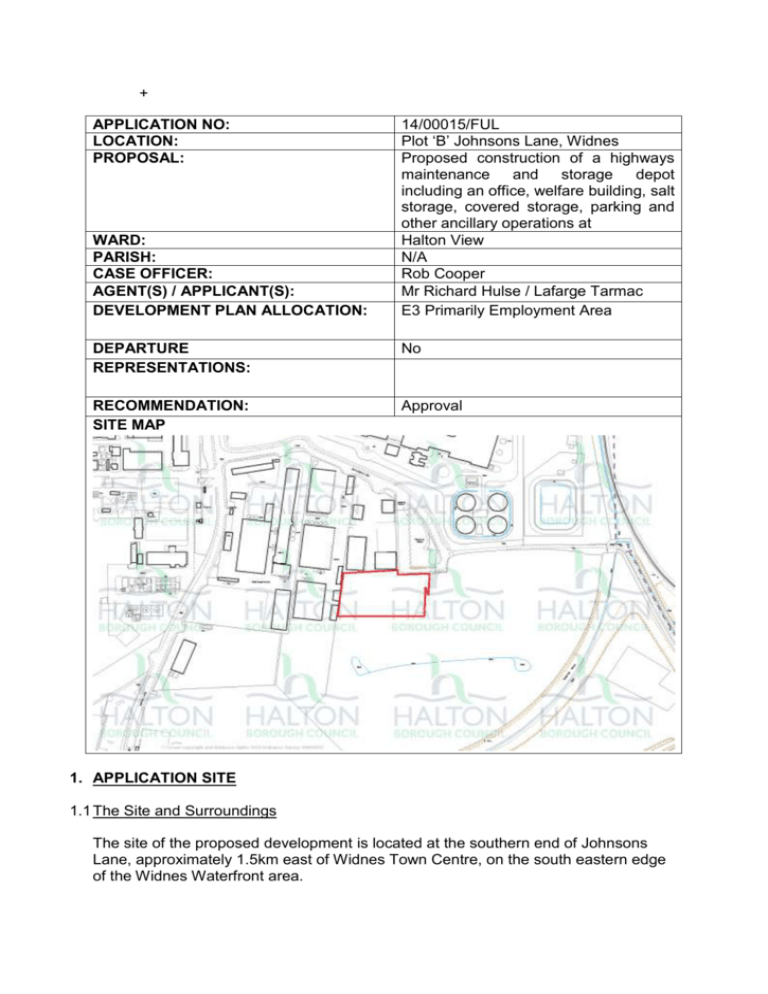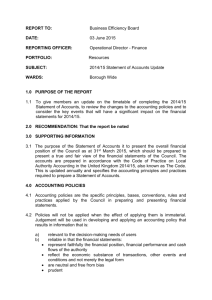14 00015 FUL Johnsons Lane Plot 'B' , item 59. DOCX 187 KB
advertisement

+ APPLICATION NO: LOCATION: PROPOSAL: WARD: PARISH: CASE OFFICER: AGENT(S) / APPLICANT(S): DEVELOPMENT PLAN ALLOCATION: 14/00015/FUL Plot ‘B’ Johnsons Lane, Widnes Proposed construction of a highways maintenance and storage depot including an office, welfare building, salt storage, covered storage, parking and other ancillary operations at Halton View N/A Rob Cooper Mr Richard Hulse / Lafarge Tarmac E3 Primarily Employment Area DEPARTURE REPRESENTATIONS: No RECOMMENDATION: SITE MAP Approval 1. APPLICATION SITE 1.1 The Site and Surroundings The site of the proposed development is located at the southern end of Johnsons Lane, approximately 1.5km east of Widnes Town Centre, on the south eastern edge of the Widnes Waterfront area. 1.2 Planning History 05/00979/HBCFUL - Proposed change of use of land for use as a temporary mobile caravan park (23 No. units), granted permission in January 2006. 99/00270/FUL - Proposed erection of warehouse/distribution centre, with ancillary offices, granted permission June 1999. 2. THE APPLICATION 2.1 Proposal Description Proposed construction of a highways maintenance and storage depot including an office, welfare building, salt storage, covered storage, parking and other ancillary operations, at Plot ‘B’ Johnsons Lane, Widnes. 3. POLICY CONTEXT 3.1 National Planning Policy Framework The National Planning Policy Framework (NPPF) was published in March 2012 to set out the Government’s planning policies for England and how these should be applied. Paragraph 196 states that the planning system is plan led. Applications for planning permission should be determined in accordance with the development plan unless material considerations indicate otherwise, as per the requirements of legislation, but that the NPPF is a material consideration in planning decisions. Paragraph 197 states that in assessing and determining development proposals, local planning authorities should apply the presumption in favour of sustainable development. Paragraph 14 states that this presumption in favour of sustainable development means that development proposals that accord with the development plan should be approved, unless material considerations indicate otherwise. Where a development plan is absent, silent or relevant policies are out of date, planning permission should be granted unless any adverse impacts of doing so would significantly and demonstrably outweigh the benefits when assessed against the policies in the NPPF; or specific policies within the NPPF indicate that development should be restricted. 3.2 Halton Unitary Development Plan (UDP) (2005) The site is allocated as a Primarily Residential Area in Policy E3 of the Halton Unitary Development Plan (UDP) and the key policies, which relate to the development, are:The following national and Council Unitary Development Plan policies and policy documents are relevant to this application: BE1 General Requirements for Development BE2 Quality of Design BE22 Boundary Walls and Fences GE21 Species Protection TP6 Cycle Provision as Part of New Development TP12 Car Parking TP17 Safe Travel for All 3.3 Halton Core Strategy (2013) The following policies, contained within the Core Strategy are of relevance: CS2 Presumption in Favour of Sustainable Development CS15 Sustainable Transport CS18 High Quality Design CS20 Natural and Historic Environment 3.4 Relevant SPDs Widnes Waterfront Supplementary Planning Document 4. CONSULTATIONS Adjacent properties have been notified and the application advertised by means of site and press notices. The Council’s Highways Engineer, Environmental Health Officer, Cheshire Wildlife Trust and United Utilities have been consulted. Any comments received are summarised below. 4.1 HBC Highways Does not raise any objections to the proposed development. 4.2 The Health and Safety Executive HSE does not advise on safety grounds, against the granting of planning permission in this case. 4.3 United Utilities No objection to the proposal provided that conditions in relation to drainage are attached to any approval, they also note that a United Utilities easement runs across the site. 5. REPRESENTATIONS No representations have been received from local residents or neighbouring businesses. Any further comments from neighbours or consultees will be reported orally to Committee. 6. ASSESSMENT The Proposed Development The applicant has explained that there is a need in the area for a suitable and appropriate depot and office infrastructure from which to deliver and manage the service at a reduced cost to aid the efficient operation of the Halton and Warrington Highways services. The site provides the opportunity to locate the depot and office functions along with staff members from the two Local Authorities to help deliver a successful delivery of the service. The site compound and ancillary facilities will provide employment for over 60 staff, drivers and operatives. The development will consist of the following: The main building consists of a large steel framed shed cladded in white tensile fabric, to house the stockpile of winter rock salt. This building would have a footprint of 38m by 20m, with a maximum height of 13.5m. A second building would be required to provide covered storage bays to be used for the storage of unbound road materials including sub base aggregate materials and sand. The office building will consist of a pre-fabricated building 18m by 9.7m to provide of space for administrative staff. The office building and the welfare block would be coloured in the Lafarge Tarmac corporate green colour. A welfare block is also proposed to provide 94.1Sq.m in floor area, the building would provide toilets, showers and mess facilities and a kitchen for staff. The proposal also includes the siting of three storage containers and the siting of a ‘hot box’. This is a large container capable of storing hot asphalt for up to 48hours. The proposal is to secure the site with 2.4m high galvanised steel palisade fence and a 7.5m wide galvanised steel palisade gate. The proposal includes 12m high lighting columns which are shown of the proposed layout drawing, however there is no detail of the actual lighting units or level of luminescence. Principle of the Development The site is located within a designated employment area therefore Policy E3 of the Unitary Development Plan, the proposed use as a highways depot is a Sui Generis use. Policy E3 allows for the suitable Sui Generis uses to be located within Primarily Residential Areas. This proposal would mainly consist of an open yard for the parking of highways maintenance vehicles and plant, there would be one large shed to be used for the storage of rock sat for the winter gritting of roads, and other associated buildings including office and welfare facilities. The nature and character of the use is consistent with the surrounding industrial area, and in principle is considered to comply with UDP and Core Strategy Policy. Design and appearance The general design and appearance of the buildings would be quite utilitarian in appearance, given the nature of the use is considered to be acceptable and complies with Design Policy BE2, Design of New Industrial and Commercial SPD. However it is recommended that samples of the final external materials are submitted are submitted for approval by condition. Amenity The site is located within the Widnes Waterfront area. The surrounding neighbouring uses are a mix of industrial and waste treatment facilities in nature. To the north is the United Utilities sludge incinerator facility, to the north is the Councils waste transfer station ran by Veolia, and to east is a waste paper recycling site, and to the west is the Fiddlers Ferry power station. To the south is an area of open space, this appears un-development, but is however a former ICI tip. The nearest residential properties are located to the north of Fiddlers Ferry Road 700m north west of the site. Between the application site and the nearest residential properties there are a number of roads, and other industrial estates that cause a physical separation. Ecology The EC Habitats Directive 1992 requires the UK to maintain a system of strict protection for protected species and their habitats. The Directive only allows disturbance, or deterioration or destruction of breeding sites or resting places: (a) in the interests of public health and public safety, or for other imperative reasons of overriding public interest, including those of a social or economic nature and beneficial consequences of primary importance for the environment, and provided that there is (b) no satisfactory alternative and (c) no detriment to the maintenance of the species population at favourable conservation status in their natural range. The UK has implemented the Directive in the Conservation (Natural Habitats etc) Regulations 2010 (as amended) which contain two layers of protection (i) a requirement on Local Planning Authorities (“LPAs”) to have regard to the Directive’s requirements above, and (ii) a licensing system administered by Natural England and supported by criminal sanctions. Halton Core Strategy Policy CS20 and Halton UDP Policy GE21 seek to protect habitats from destruction and indicates that development which adversely affects habitats would not be accepted. Circular 6/2005 advises LPAs to give due weight to the presence of protected species on a development site to reflect EC requirements. “This may potentially justify a refusal of planning permission.” The NPPF advises LPAs to conserve and enhance biodiversity: if significant harm from a development cannot be avoided (through locating on an alternative site with less harmful impacts) or adequately mitigated, or as a last resort, compensated for, planning permission should be refused. Natural England`s standing advice is that, if a (conditioned) development appears to fail the three tests in the Habitats Directive, then LPAs should consider whether Natural England is likely to grant a licence: if unlikely, then the LPA should refuse permission: if likely, then the LPA can conclude that no impediment to planning permission arises under the Directive and Regulations. Natural England has been consulted and their comments will be reported to members. Due to the presence of pond in close proximity to the application site, the application has been supported with the submission of a Great Crested Newt survey report. It was concluded that no known GCN/amphibian breeding sites, other water bodies or aquatic habitat will be destroyed or damaged as a consequence of the proposed plot B development, and temporary disturbance top the terrestrial habitat of the ponds will be satisfactory mitigated and managed. The report has concluded that the implementation of a non-licensed mitigation and habitat compensation measures strategy involving the use of reasonable avoidance measures (RAM) and is appropriate for the proposed development. The RAM and habitat compensation measures to be implemented will quantitatively, and qualitatively and contextually address the predicted ‘low’ level development effect and scale of impact on any GCN/amphibian populations potentially associated with the plot B site and local area. The successful implementation of the RAM and habitat compensation measures detailed below will effectively minimise the risk of breaching legislation relating to GCN/amphibian populations and will ensure that the favourable conservation status of GCN / amphibian populations associated with plot B development site and local area will be maintained in their natural range. The Councils Ecological Advisors at Cheshire Wildlife trust are satisfied with the survey that has been carried out and the measures outlined in the reasonable avoidance measures. As such, the proposals accord with the Habitat Regulations and policies CS20 and GE21 which are consistent with guidance within the National Planning Policy Framework. Highways The site would be accessed of a proposed new road which is to be constructed by Halton Borough Council, the proposed new road would form a continuation southerly extent of Johnsons Lane, the design of the road is to facilitate the future development of the adjoining land. The site layout provides for 34 staff car parking spaces including one disabled space, the site layout also provide 2 no. parking spaces for motorcycles and secure storage for 4 bicycles. The site is likely to require drainage for foul and surface water and may require interceptors may be required, details of these have not been provided upfront and a condition is recommended for full details to be submitted for approval. The Highways Authority has been consulted and they have raised no concerns. 7. CONCLUSIONS The proposed development would bring in to use a vacant site in the Widnes Waterfront Area, and provide for a much needed highways depot to support the maintenance of the local highway network. The proposal complies with the Halton Unitary Development Plan Policies BE1, BE2, GE21 and TP12 and Halton Core Strategy Local Plan, in particular Policies CS2, CS12 and CS18, and CS20. It is considered that any outstanding matters can be adequately controlled by condition. On that basis, the application is recommended for approval. 8. CONDITIONS 1. Standard Condition relating to timescale and duration of the permission; 2. Development to be carried out in accordance with the submitted plans (BE1) 3. Materials condition, requiring the submission and approval of the materials to be used (BE2); 4. Submission, agreement and implementation of drainage scheme for disposal of foul and surface waters (BE1, PR5) 5. Submission and approval of details of external lighting (PR4) 9. SUSTAINABILITY STATEMENT As required by: Paragraph 186 – 187 of the National Planning Policy Framework; The Town and Country Planning (Development Management Procedure) (England) (Amendment No.2) Order 2012; and The Planning (Listed Buildings and Conservation Areas) (Amendment) (England) Regulations 2012. This statement confirms that the local planning authority has worked proactively with the applicant to secure developments that improve the economic, social and environmental conditions of Halton.






